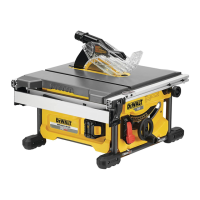17
ENGLISH
6. Tighten the riving knife lockknob.
NOTE: Follow the same procedure for the riving knife.
WARNING: Before connecting the table saw to the power
source or operating the saw, always inspect the blade
guard assembly for proper alignment and clearance
with saw blade. Check alignment after each change of
bevelangle.
WARNING: To reduce the risk of serious personal injury,
DO NOT operate saw if blade assembly is not securley
clamped inplace.
When properly aligned, the riving knife
23
will be in line with
the blade at both table top level, and at the top of the blade.
Using a straight edge, ensure that the blade
2
is aligned with
the riving knife
23
. With power disconnected, operate the
blade tilt and height adjustments through the extremes of
travel and insure the blade guard assembly clears the blade in
alloperations.
WARNING: Correct mounting and alignment of the blade
guard assembly is essential to safeoperation!
Mounting the Throat Plate (Fig. E)
1. Align the throat plate
17
as shown in figureE, and insert
the tabs on the back of the throat plate into the holes on the
back of the tableopening.
2. Turn the locking screw
30
with a screw driver clockwise 90°
to lock the table insert inplace.
3. The throat plate includes four adjustment screws which
raise or lower the throat plate. When properly adjusted, the
front of the throat plate should be flush or slightly below the
surface of the table top and secured in place. The rear of the
throat plate should be flush or slightly above the tabletop.
WARNING: Never use the machine without the throat
plate. Immediately replace the throatplate when worn
ordamaged.
Removing the Throat Plate
1. Remove the throat plate
17
by turning the locking
screw
30
with a screw driver 90˚ anti-clockwise
2. Pull throat plate up and forward to expose the inside of the
saw. DO NOT operate the saw without the throatplate.
Fitting the Rip Fence (Fig. F)
The rip fence can be installed in two positions on the
right(Position 1 for 0mm to 510mm ripping, and Position 2
for 100mm to 610mm ripping.) and one position on the left of
your tablesaw.
1. Unlock the rip fence latches
19
.
2. Holding the fence at an angle, align the locator pins(front
and back)
31
on the fence rails with the fence head
slots
32
.
3. Slide the head slots onto the pins and rotate the fence down
until it rests on therails.
4. Lock the fence in place by closing the front and back
latches
19
onto therails.
Fixing to Workbench (Fig. A)
• The machine frame between the feet on each side is
provided with two holes
9
which allow fixing on a
workbench. Use the holes diagonally.
• To improve the handling fix the machine on a piece of
plywood of min 15 mm thick.
When in use the plywood sheet can be clamped to the
workbench. This allows easier transportation of the machine, by
releasing the clamps.
ADJUSTMENTS
Blade Adjustment
Blade Alignment (Parallel to Mitre Slot)
(Fig. G)
WARNING: Cut Hazard. Check the blade at 0˚ and 45˚
to make sure blade does not hit the throat plate, causing
personalinjury.
If the blade appears to be out of alignment with the mitre slot
on the table top, it will require calibration for alignment. To
realign the blade and mitre slot, use the following procedure:
WARNING: To reduce the risk of injury, turn unit
off and disconnect machine from power source
before installing and removing accessories, before
adjusting or changing set-ups or when making
repairs. An accidental start-up can causeinjury.
1. Using a 5mm hex wrench, loosen rear pivot bracket
fasteners
33
, located on the underside of the table, just
enough to allow the bracket to move side-to-side.
2. Adjust the bracket until the blade is parallel to the mitre
gaugeslot.
3. Tighten the rear pivot bracket fasteners to 110–120
in-lbs(12.5–13.6 Nm).
Blade Height Adjustment (Fig. A)
The blade can be raised and lowered by turning the blade
height adjustment wheel
6
.
Make sure the top three teeth of the blade are just breaking
through the upper surface of the workpiece when sawing. This
will ensure that the maximum number of teeth are removing
material at any given time, thus giving optimumperformance.
Aligning Guard Assembly to Blade (Fig. H)
1. Remove the throat plate. Refer to Removing Throat Plate
underAssembly andAdjustments.
2. Raise the blade to full depth of cut and 0° bevelangle.
3. Locate the three small set screws
33
. These screws will be
used to adjust the riving knifeposition.
4. Lay a straight edge on the table against two blade tips. The
riving knife should not touch the straightedge.
5. If adjustment is needed, loosen the two larger lock
screws
35
.
Ташев-Галвинг ООД
www.tashev-galving.com

